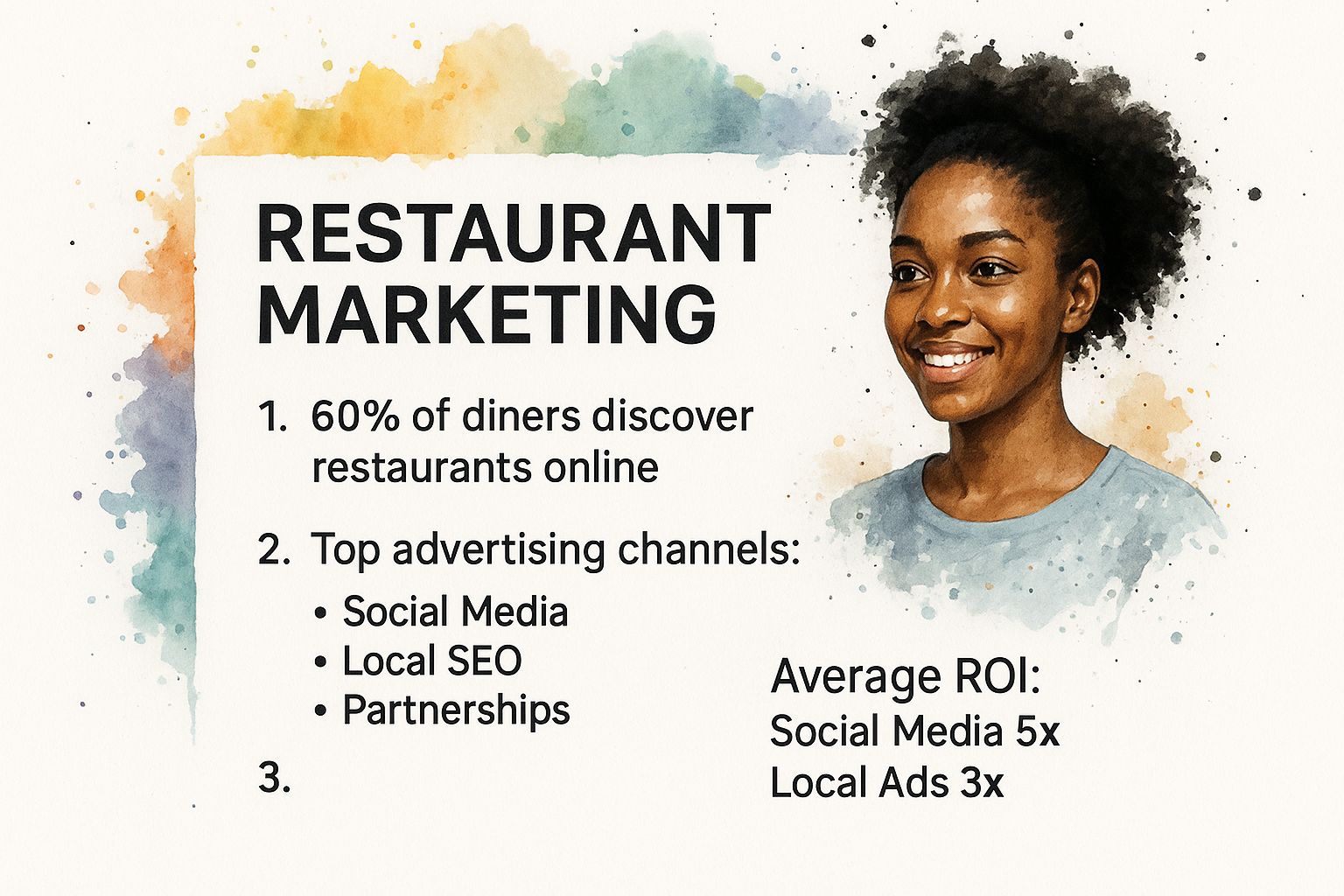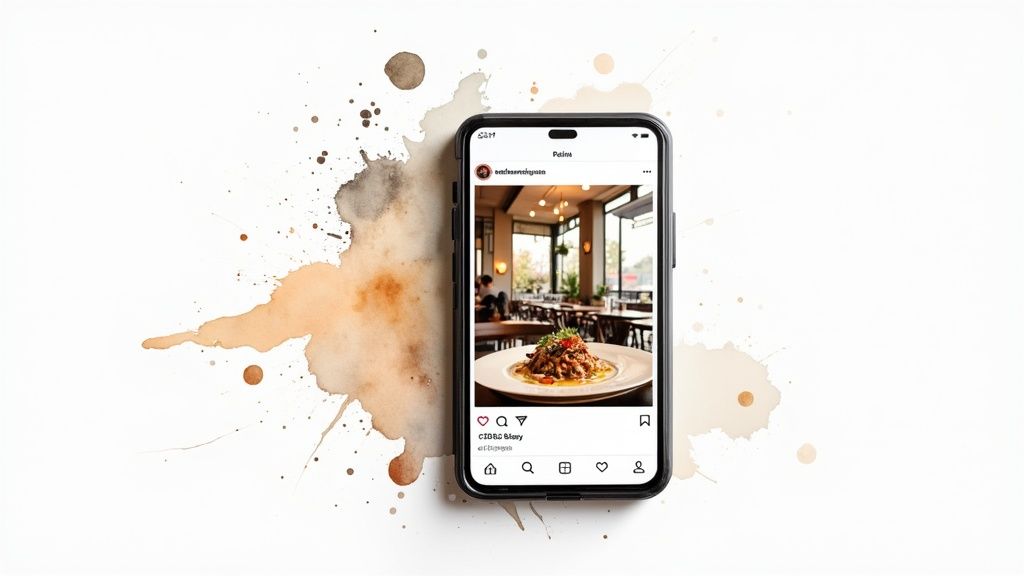Before you can effectively advertise your restaurant, you need a solid game plan. You can’t just throw ads out there and hope for the best; you need a blueprint that guides every decision you make. This all starts with a cohesive, multi-channel digital strategy that serves as the foundation for all your campaigns.
Without this groundwork, even the most creative ads can fall flat, wasting your precious time and budget. This guide will walk you through how to advertise restaurants effectively, from defining your audience to turning new diners into loyal regulars.
Define Your Target Diner
The first, and most critical, step is getting laser-focused on who you're actually trying to reach. A "one-size-fits-all" approach is a recipe for disaster. You have to go deeper than a generic idea of "customers" and build out detailed diner personas.
Are you trying to attract young professionals for a lively happy hour? Or is your sweet spot families looking for a kid-friendly weekend dinner? Maybe you cater to couples celebrating a special occasion with an upscale dining experience.
Each of these groups has completely different motivations, budgets, and online hangouts. The young professional probably scrolls Instagram for ideas, while the family is more likely to do a quick "restaurants near me" search on Google. Understanding this is everything.
A well-defined audience is the difference between shouting into the void and having a meaningful conversation with your next loyal customer. It dictates the platforms you use, the message you craft, and the offers you promote.
Once you know who you're talking to, you can set clear, measurable goals. Vague ambitions like "get more customers" are impossible to track and even harder to optimize.
Set Realistic and Measurable Goals
Instead, you need to aim for tangible outcomes that directly boost your bottom line. This simple shift in thinking changes your ad spend from an expense into a true investment in growth.
Here’s what that looks like in practice:
- Increase online reservations by 30% in the next quarter.
- Boost weekday lunch sales by 20% through targeted promotions.
- Grow your email list by 500 subscribers by offering a compelling first-timer discount.
- Drive 100 new delivery orders per week through a dedicated Uber Eats campaign.
Goals like these give your advertising a clear purpose and a benchmark for success. You can see what’s working (and what isn't) across platforms like Facebook, Google, and Instagram. Modern advertising isn't just about reach; it's about results. In fact, restaurants that have truly embraced digital platforms have seen customer engagement jump by over 25%. You can learn more about these trends and how to use them by reviewing detailed restaurant marketing insights.
The data doesn't lie. Most diners are finding new restaurants online, primarily through social media and local search.

This just hammers home how critical a strong digital presence is. Social media, in particular, often delivers an incredible return for restaurants that get it right.
To bring it all together, let’s look at the core components of a successful advertising plan.
Core Components of a Successful Restaurant Ad Strategy
A powerful advertising plan for any restaurant is built on a few essential elements. This table breaks down what you need and why it matters.
| Component | Key Objective | Example Action |
|---|---|---|
| Diner Personas | To deeply understand your ideal customer. | Create a profile for "Weekend Wendy," a 35-year-old mom looking for family-friendly dining options. |
| Measurable Goals | To set clear, trackable targets for success. | Aim to increase online reservations through your website by 20% in the next 3 months. |
| Unique Selling Prop. | To define what makes your restaurant special. | Highlight your "farm-to-table" sourcing and exclusive menu items in all ad copy. |
| Channel Selection | To choose the right platforms to reach your audience. | Focus on Instagram Reels and Facebook Stories for a younger demographic. |
Getting these foundational pieces in place ensures that your strategy is built to last and deliver real-world results.
Craft Your Unique Selling Proposition
Finally, your strategy needs to clearly define your Unique Selling Proposition (USP). This is the one compelling reason a diner should walk into your restaurant instead of the one down the street. It’s the heart of your brand story and the main theme of every ad you run.
What is it that makes you stand out? Is it your farm-to-table ingredients? Your award-winning chef? Maybe it’s your unbeatable happy hour deals or your cozy, romantic atmosphere.
Whatever your USP is, it must be clear, concise, and consistently communicated in everything you do. It’s what makes your restaurant memorable and gives people a reason to not just try you once, but to become regulars.
How to Advertise Restaurants on Facebook and Instagram
Your next customer isn't thumbing through the Yellow Pages. They're scrolling through their social media feeds right now, looking for a place to eat tonight. This is precisely why platforms like Facebook and Instagram have become absolute goldmines for any restaurant that knows how to use them.
It's about more than just boosting a post and hoping for the best. A smart, strategic ad campaign can put your restaurant directly in front of a hungry, local audience that's ready to make a reservation or place an order. It's all about using the powerful tools these platforms offer to drive real business—not just likes.
Start with the Right Campaign Objective
Before you even think about creative, you need to tell Meta's algorithm what you want to accomplish. This is your first and most critical decision. Choosing the right campaign objective literally tells the system how to spend your money and who to show your ads to. For restaurants, a few objectives are consistently the most effective.
- Reach: This is your digital megaphone. If you’re a brand-new restaurant about to have your grand opening or just want to make sure everyone within a 5-mile radius knows your name, a Reach campaign is perfect. It’s designed to get your ad in front of the maximum number of people in your area.
- Traffic: Use this when you have a specific destination in mind. Want to drive people to your online ordering page? Your reservations portal? A page on your website detailing a special event? The Traffic objective is your best bet.
- Engagement: Got a post that's already getting a lot of organic love? Maybe it’s a stunning video of a new dish or a photo of your patio on a perfect summer evening. An Engagement campaign amplifies that success, pushing it out to a wider audience to rack up more likes, comments, and shares, which builds incredible social proof.
Getting this right from the start is what separates a genuine performance-driven campaign from just another post. It ensures your ad spend is tied to a measurable outcome.
The Meta Ads Manager is where all this magic happens. It’s the control center for fine-tuning every aspect of your advertising.

This screenshot shows you that initial, crucial step of creating a campaign. Picking the right goal here—whether it's building awareness or driving direct sales—is the foundation that dictates how your budget is used and who sees your ads.
Pinpoint Targeting to Reach Your Ideal Diners
Once your objective is locked in, it’s time to define your audience. This is where you can stop wasting money showing ads to people who will never walk through your door and start focusing on those most likely to become regulars.
Don't just stick to basic demographics. You need to layer your targeting to build a highly specific profile of your ideal diner.
- Location Targeting: For a restaurant, this is completely non-negotiable. Target people within a tight radius of your location—think 3 to 10 miles, depending on how dense your city is. You can even get more specific by targeting people "living in or recently in this location" to catch both locals and tourists looking for a great meal.
- Interest Targeting: What are your ideal customers passionate about? Dive into interests like "foodie culture," "fine dining," "craft cocktails," or "vegan cuisine." You can even target fans of specific food bloggers or publications in your area.
- Behavioral Targeting: This is where it gets really powerful. You can target users based on life events and online behaviors. Someone who "recently moved" is actively looking for new local spots. Another incredibly useful behavior is "Engaged Shoppers," which identifies people who have a history of clicking "Shop Now" or similar buttons.
Let’s put it all together. An Italian bistro in Chicago could target users within a 5-mile radius who are interested in "Italian cuisine" and "wine," and who also have an upcoming anniversary. That level of precision is how you make your ad budget work smarter, not harder.
Create Ad Creative That Actually Stops the Scroll
In a fast-moving feed, your ad's creative is what earns the stop. Generic stock photos are a death sentence for a restaurant ad. Your visuals need to be authentic, mouth-watering, and impossible to ignore.
A few creative formats work like a charm for restaurants:
- High-Quality Video: A short, snappy video is king. Show your chef plating a signature dish, a bartender mixing a vibrant cocktail, or give a quick tour of your dining room's ambiance. It’s far more captivating than a static image.
- Carousel Ads: This format is perfect for showcasing your greatest hits. Use each card in the carousel to feature a different best-selling dish, and link each one to a specific part of your menu. You're essentially giving users a mini-tour of your offerings.
- User-Generated Content (UGC): Did a happy customer post an amazing photo and tag your restaurant? Reshare it! UGC is the ultimate social proof. It's a real person telling potential diners, "Hey, I loved this place, and you will too."
Finally, you have to be testing. Always. Run A/B tests on your ad copy, headlines, and visuals to see what truly connects with your audience. Does an ad promoting your happy hour special get more clicks than one focused on your weekend brunch? The data will give you the answer, allowing you to constantly refine your campaigns for a better return.
For more in-depth strategies and tips, you can find a ton of valuable information on the Digital Advertising Direct blog.
Dominating Local Search With Google Ads
While social media is great for building desire, Google Ads is where you capture intent. When someone searches "best tacos near me" or "Italian restaurant open now," they aren't just browsing. They have their wallet out, and they're looking for a place to eat right now. This is the moment of truth. If your restaurant doesn't show up, for all intents and purposes, you don't exist. This is exactly why mastering Google Ads is a game-changer for restaurants.
It’s all about being the most obvious, immediate solution to a hungry person’s problem. You’re not just paying for visibility; you're paying to be the answer at the exact moment a customer is ready to spend money.
Choosing Your Google Ads Campaign Type
Google provides a toolbox of campaign types, and picking the right one is crucial. Using a Display campaign when you really need a Search campaign is just burning cash. Let's break down the best options for a restaurant:
- Search Campaigns: This is your bread and butter. We're talking about the text-based ads that pop up at the top of Google search results. They are absolutely perfect for snagging those high-intent customers actively searching for what you offer, like "sushi delivery downtown."
- Performance Max (PMax): This is Google's all-in-one, AI-powered workhorse. You feed it your assets—photos, videos, ad copy—and Google’s AI takes over, pushing your ads across all its properties: Search, YouTube, Maps, Display, you name it. It's built to maximize reach and drive specific actions, like online orders or reservations.
- Display Campaigns: These are the visual ads—banners and images—that you see on websites all over the Google Display Network. They're less about catching someone in the act of searching and more about building brand awareness. Think of it as a digital billboard, reminding people about your amazing weekend brunch while they read the local news online.
Knowing the difference is key. If you need to fill seats tonight, pour your budget into Search and Performance Max. If you're playing the long game and building your brand, layer in some Display campaigns to stay top-of-mind.
You'll manage all of this from the Google Ads platform.

This is where it all begins. You'll define your goals right from the start, making sure every dollar you spend is aimed squarely at a real-world business outcome, whether that's more delivery orders or more butts in seats.
Local Keyword Research That Converts
The success of your Search campaigns comes down to one thing: bidding on the right keywords. For a restaurant, that means you have to think like a hungry local. Your keyword strategy needs to be laser-focused on local intent.
Forget about broad, expensive terms like "best food." That’s a waste of money. You want to zero in on specific, location-based phrases that scream "I'm ready to eat now."
Essential Local Keyword Formulas:
[Cuisine] in [Your City/Neighborhood](e.g., "thai food in Tribeca")[Dish] near me(e.g., "wood-fired pizza near me")[Restaurant Type] open now(e.g., "family restaurant open now")[Occasion] dining [Your City](e.g., "anniversary dining Boston")
Pro Tip: Don't forget to target keywords around your specific features. Things like "restaurants with outdoor seating" or "dog-friendly patios" are gold. These long-tail keywords often have way less competition and attract exactly the kind of customer you're looking for.
These aren't just search terms. They're direct requests from people who are about to make a decision. Win these searches, and you win their business.
Optimize Your Google Business Profile
Your Google Business Profile (GBP) is arguably the single most powerful local marketing tool you have, and it works in tandem with your Google Ads. A complete, optimized, and active GBP is non-negotiable.
When someone searches for your restaurant, your GBP is that rich panel that pops up with your map location, hours, photos, and reviews. You need to make sure you link your Google Ads account to your GBP. This unlocks Location Extensions, which automatically add your address, a map pin, and your phone number to your search ads.
This simple step doesn't just make your ad bigger; it dramatically increases click-through rates by giving a searcher every piece of information they need in one clean package.
Writing Ad Copy That Drives Action
Finally, your ad copy has to seal the deal. You have a few short lines to convince someone your restaurant is the place to go. Your copy needs to be punchy, clear, and create a sense of urgency.
- Highlight Your Unique Selling Proposition (USP): What makes you special? Tell them! Talk about your "award-winning burgers," "farm-to-table ingredients," or "daily happy hour specials."
- Include a Strong Call to Action (CTA): Don't just give information; tell them what to do next. Use direct, action-oriented phrases like "Reserve Your Table Now," "Order Online Today," or "View Our Menu."
- Create Urgency: Give them a reason to act now. Mentioning time-sensitive offers like "Lunch Special Ends at 3 PM" or "Limited Seating Available" can be incredibly effective.
For restaurants that want to see these kinds of results without getting bogged down in the day-to-day management, looking into an integrated solution can be a huge time-saver. You can see how our Adfuel Plus program helps businesses automate and get the most out of their Google Ads, freeing you up to focus on what you do best—running an amazing restaurant.
Expanding Your Reach With Programmatic Display Ads
So you’ve got your social media and search ads running. What’s next? Let's talk about the next layer of your advertising strategy: keeping your restaurant top-of-mind even when people aren't actively looking for a place to eat.
Imagine this: a known local foodie just finished reading a rave review of your biggest competitor. Moments later, while browsing a news site, they see a beautiful, mouth-watering ad for your signature dish. That’s not magic; it’s programmatic display advertising.
It might sound complicated, but the idea is actually pretty simple. Programmatic advertising is an automated way to buy digital ad space. It lets you show visual banner ads to very specific groups of people across thousands of different websites, from major news portals to niche mobile apps. It’s all about being in the right place at the right time.
Hyper-Targeting With Geofencing and Behavior
The real power of programmatic advertising comes from its incredibly sophisticated targeting options, which go way beyond the basics. For a restaurant, two methods are absolute game-changers:
-
Geofencing: This is where you draw a virtual "fence" around a real-world location. You can then show your ads to anyone who walks into that zone. A steakhouse, for example, could geofence a nearby convention center during a big trade show, hitting attendees with ads for their happy hour specials. You can even get aggressive and target your competitors' locations—a tactic we call geo-conquesting.
-
Behavioral Targeting: This approach focuses on what people are actually doing online. You can target users based on their browsing habits, putting your ads in front of people who are always on recipe sites, local food blogs, or a certain critic’s review page. If someone’s search history is full of "best brunch spots," your ad for bottomless mimosas can pop up on the very next website they visit.
This level of precision means your budget is spent reaching people who have already shown they’re interested in dining out. Your ad spend becomes dramatically more efficient.
How This Works in the Real World
So, what does this actually look like for a local restaurant? Programmatic isn't just for the big national chains with massive budgets. Independent spots can use it to hit very specific, practical goals.
For example, a neighborhood pizzeria could run banner ads that only show up on the sports page of the local news site on game days. Or an upscale bistro could target people who have recently looked up tickets for the city’s performing arts center, tempting them with a pre-theater dinner menu.
The goal here isn't always about getting an immediate click. It's about building powerful brand recall. When that person later thinks, "Where should we go for dinner tonight?" your restaurant is already a familiar, appealing option because they've seen your ads multiple times across their favorite sites.
By layering geofencing on top of behavioral data, you create a campaign that’s both geographically relevant and contextually smart. It’s a proactive strategy that perfectly complements the reactive nature of search ads, making sure you catch potential diners at every stage of their decision-making process. This is how you solidify your spot in the local market and become the go-to choice for hungry customers.
Turn Clicks Into Loyal Customers With a CRM

A great digital ad might get someone through your door once. That's a win, but it's only half the battle. The real magic—and long-term profit—happens when you have a smart follow-up system that turns that first-time visitor into a regular. This is how you bridge the gap between ad spend and sustainable growth.
The key to making this happen is a Customer Relationship Management (CRM) system. Think of it as your restaurant's digital memory. It captures vital customer details and then automates the kind of personalized communication that builds a genuine community around your brand. Without it, you're just endlessly paying to attract new faces instead of nurturing the valuable customers you've already won.
Capturing Customer Data From Your Ad Campaigns
Every single ad you run is a golden opportunity to grow your customer database. The goal is simple: offer something in your ad that’s valuable enough for a potential diner to happily trade their contact info for it. This little exchange is the first step in opening a direct line of communication.
Here’s what this looks like in the real world:
- Facebook "2-for-1 Appetizer" Ad: A user scrolls, sees your delicious offer, and clicks a button. A lead form pops up, pre-filled with their Facebook info (name, email). They get their voucher, and you get a new contact added straight to your CRM.
- Google Search Ad for Reservations: Someone searches for a place to eat, and your ad pops up with "Book Online & Get a Free Dessert." The link takes them to a simple booking page where they enter their name, email, and phone to lock in their table and their treat.
- Instagram Story Promotion: You tease a "secret menu item" in a Story ad. The only way to unlock it? By signing up for your VIP list through the link in your bio.
In every scenario, the ad does more than just drive a single action—it secures a long-term marketing asset. This is absolutely fundamental to learning how to advertise restaurants for lasting growth, not just a temporary bump in traffic.
Building Automated Follow-Up Sequences
Once that contact information is in your CRM, the system can get to work for you. The beauty here is automation. You can create email and SMS campaigns that feel personal and timely, driving repeat business without you having to manually send every single message.
This is where you build loyalty at scale. The right message at the right moment makes a customer feel seen and appreciated, turning a good first meal into a lasting relationship.
By transforming ad clicks into CRM contacts, you’re not just making a sale; you’re starting a conversation. This is the single most effective way to maximize the lifetime value of every customer your advertising brings in.
This direct line is more critical than ever. With takeout and delivery becoming a regular habit for so many, being able to reach your customers directly is a massive advantage. In fact, it's predicted that by 2025, 43% of consumers will order takeout or delivery at least once a week. You need a way to stay connected.
Real-World Campaigns That Drive Repeat Visits
An automated CRM workflow can run all sorts of campaigns to keep your restaurant top-of-mind and give diners a great reason to come back. The secret is to make every message feel relevant and valuable.
Here are a few proven automated campaigns you can set up:
- The "First-Timer Thank You": About 24 hours after a new customer books a table or orders online, your CRM sends a "thank you" email with a small perk, like 15% off their next visit.
- The Birthday Special: The system tracks birthdays and automatically sends a personalized email or text a week beforehand, offering a free dessert or drink to celebrate with you.
- The "We Miss You" Campaign: If a customer hasn't been back in 90 days, the system can trigger a friendly "we miss you" message with a compelling offer to entice them back.
- Seasonal Menu Alerts: Announce your new fall menu or summer cocktail list to your email subscribers before you post it on social media. It makes them feel like insiders.
Integrating a CRM is the final, essential piece of a modern restaurant advertising puzzle. If you need help structuring these campaigns or want to see how a fully managed system can handle it all for you, feel free to schedule a free strategy session with our team.
Common Questions About Advertising a Restaurant
If you’re feeling a bit lost in the world of digital advertising, you’re not alone. It’s a space filled with different platforms, confusing metrics, and a ton of conflicting advice. It’s only natural to have questions about where to start or what really matters.
Let’s cut through the noise. Below, we'll tackle some of the most common questions we hear from restaurant owners. The goal is to give you clear, straightforward answers so you can move forward with confidence.
How Much Should I Spend on Advertising?
This is the big one, isn't it? While there’s no universal "right" answer, a solid benchmark for most restaurants is to earmark between 3% and 6% of your total revenue for marketing.
A brand-new spot trying to get its name out there will naturally lean toward the higher end of that range. On the flip side, an established local favorite with a built-in following might find that 3% is plenty.
But here’s the real secret: the raw dollar amount isn't what matters most. The crucial metric is your Return on Ad Spend (ROAS). If you’re spending $500 a month but that investment brings in $2,500 worth of new orders, you've got a winning formula. The key is to start with a budget that doesn’t make you sweat, track your results obsessively, and then double down on what’s actually working.
What Is the Best Platform to Advertise On?
The "best" platform is the one where your ideal diner spends their time. It’s almost never an either/or choice; the strongest strategies use a few channels that play well together.
Think of it like a toolbox. You need the right tool for the job.
- For Immediate Hunger Pains: Google Ads is your best friend. You’re catching people at the exact moment they’re searching for "tacos near me" or "best pizza delivery." It’s pure, high-intent marketing.
- For Building a Vibe and a Following: This is where Facebook and Instagram shine. They are visual storytelling powerhouses. You can show off your mouth-watering dishes, your restaurant's unique atmosphere, and build a genuine community with local foodies.
- For Hyper-Local Targeting: If you want to get really specific, programmatic display with geofencing is incredibly powerful. You can serve ads to people inside a nearby convention center, a local hotel, or a competing business district.
A classic mistake is spreading the budget too thin across every platform imaginable. You'll get much better results by mastering one or two channels first before branching out.
Don't use Instagram to capture urgent search traffic. Choose your platform based on your goal.
How Long Until I See Results from My Ads?
This is a great question, and it has a two-part answer. You’ll see short-term indicators almost immediately. Within the first 24 to 72 hours of launching a sharp campaign on Google or Facebook, you'll start getting data—clicks, views, and maybe even a few leads. These are your early signs that things are switched on.
However, the real results—the kind that actually grow your business, like a steady stream of online reservations and a noticeable bump in revenue—take a bit more time.
It typically takes a good 30 to 90 days to gather enough data to truly optimize your campaigns. This is the window where you A/B test your ad copy and images, and more importantly, let the platform algorithms learn who your perfect customer is. Patience is a virtue in advertising. It’s a marathon, not a sprint.
FAQ Quick Reference
To make it easier, here is a quick-glance table to help you remember the key takeaways for these common advertising questions.
| Question | Short Answer | Key Consideration |
|---|---|---|
| How much should I spend? | Start with 3-6% of your revenue. | Focus on your Return on Ad Spend (ROAS), not just the initial budget. |
| What's the best platform? | It depends on your goal. | Use Google for active searches and social media for brand building and community. |
| How long does it take? | You'll see data in days, but expect real results in 30-90 days. | Allow time for data collection, testing, and optimization to truly refine your strategy. |
Getting these fundamentals right is the bedrock of a smart, effective advertising plan. By understanding the core ideas behind budgeting, platform selection, and timelines, you can stop guessing and start making decisions with a clear sense of purpose.
Ready to stop guessing and start seeing real results from your restaurant advertising? The team at DigitalAdvertisingDirect.com can build a customized strategy that drives reservations and orders, so you can focus on what you do best. Get a free, no-obligation strategy session today!


